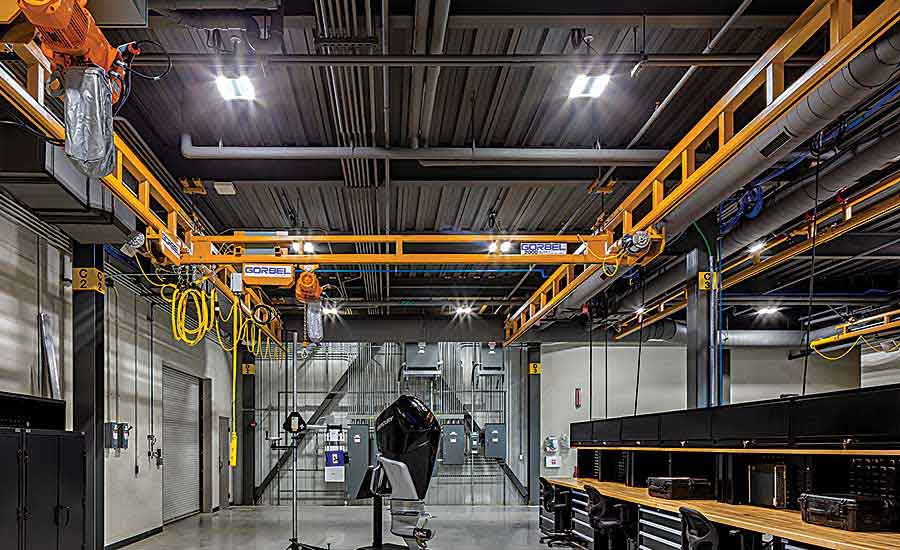Motor Manufacturer Opens State-of-the-Art NVH Testing Lab
Mercury Marine builds world-class NVH testing lab at its Wisconsin assembly plant.






One of the best things about fishing is that it’s so peaceful. Alone on the water, you can hear the eerie call of a loon, the distant splash of a breaching bass, or the honking of a passing flock of geese. That is, until some yahoo with an ancient outboard screams by, sounding more like a dragster than a fishing boat.
Avoiding such scenarios is why Mercury Marine strives to be at the forefront in noise, vibration and harshness (NVH) testing of marine engines. Founded in 1939, Mercury Marine is a division of the Brunswick Corp. Based in Fond du Lac, WI, the company makes outboard motors, inboard motors and stern-drive motors for boats. The company’s products are known worldwide for their power, efficiency, reliability and quiet operation.
Maintaining its industry-leading position requires a commitment to R&D and product testing. So, in 2018, the company decided to build a new, state-of-the-art NVH Technical Center to test future products and improve the NVH quality of their marine propulsion systems from the prop to the helm.
The company had two main requirements for the new facility. First, the Technical Center would need to support all NVH development activities for Mercury Marine and support NVH development across the entire Brunswick product line. And second, it would need to be located at Mercury’s Product Design and Engineering Center in Fond du Lac to facilitate collaboration between product development and engineering staff.
The center officially opened Dec. 6, 2018, just eight months after breaking ground. The two-story facility adds close to 20,000 square feet to Mercury’s headquarters campus, which already covered more than 2.5 million square feet. The $10 million investment gives the company the largest testing facility in the industry.
“We will continue to invest in ensuring that our engines are the most reliable and quiet engines in the world, and our new NVH Technical Center gives us the additional test capacity we need to continue to meet and exceed our product development goals,” says Tim Reid, Mercury Marine’s vice president of product development and engineering.
The new facility is Mercury’s third major expansion in the past three years. In early 2017, Mercury opened a new $24 million electro-deposition paint line, and in April 2017, the company commissioned a 4,500-ton high-pressure die-cast machine, the largest in North America.
Facility Configuration
An indoor environment designed to mitigate vibrations transmitted into the facility was essential to ensure that noise and vibration testing and sound level measurements would be accurate. Two highly flexible acoustic test chambers were designed specifically for testing marine engines, but are also configurable into standard hemi-anechoic spaces to test a wide array of other products.
An evaluation and listening room allows juries to evaluate the distinctive sounds of Mercury products. While quiet enough to allow for undisturbed evaluation, the room is not so quiet as to create an unnerving environment for participants. A technician area provides engineers with an ideal place to perform their duties. A modal test area provides space for performing modal analysis of products, as well as measurement of engine center of gravity and moment of inertia parameters. Lastly, a large instrumentation bay offers an indoor area for testing vessels up to 45 feet in length and 12 feet in beam.
Engineering and Design
The facility has a number of features to enable accurate NVH testing.
Acoustic isolation systems. With test room noise floor targets nearing noise criterion (NC) curve 10, a minimum sound transmission class (STC) of 56 was necessary to reduce unwanted airborne sound.
NC curves are a common way to measure and specify background noise in unoccupied buildings and spaces. Their purpose is to produce a single-value representation of a complete sound spectrum. A library might have an NC curve of 35 to 40; a recording studio might have an NC curve of 15 to 20. STC is an integer rating of how well a building partition attenuates airborne sound. It is used to rate walls, ceilings, floors, doors and windows. A wall with a high STC attenuates more noise than one with a lower rating.
Precast concrete panels with ratings as high as STC-61 were used to form the exterior perimeter walls. A nested room configuration minimizes background sound levels. With ground-borne vibration a concern, and test room isolation essential, the inner test room was constructed of weight-reducing metal acoustic wall panels with integrated perforated metal anechoic wedges.
Vibration isolation. Isolation of the acoustic test chambers was essential. Test room floors are 6-inch thick steel-reinforced concrete slabs designed for added stiffness to mitigate floor resonance. Coiled steel spring mounts isolate the test room floor and acoustic room structure from unwanted ground-borne vibration.
The acoustic panel test chamber and its steel structural frame are supported on the perimeter of the floor slab, where the slab transfers its dead and live loads through the isolation mounts. A 90 percent isolation efficiency from disturbing frequencies of 8 hertz and higher is achieved.
HVAC systems. The building’s HVAC systems were selected to optimize energy efficiency and provide a comfortable indoor environment. High-efficiency condensing boilers generate low-temperature hot water for use in both variable-volume, terminal-unit reheat coils and in-floor radiant heating. Self-regulating, variable-speed heating pumps keep energy consumption low.
For the test chambers, special consideration had to be given to removing exhaust from operating engines. Marine outboards discharge exhaust underwater through the hub of the propeller when operating off idle. When idling, exhaust is discharged through bypass ports above the waterline. Ventilation systems needed to safely remove exhaust gases in both modes of operation, as well as manage the heat released from the engines.
A single-pass 100 percent outside air HVAC system is used to ventilate the test room and mitigate carbon monoxide and hydrocarbon emissions. Mercury engineers select from one of three operating modes based on multiple testing parameters, including engine horsepower and anticipated thermal cycling.
With the test room constructed over a water reservoir, controlling temperature and relative humidity proved challenging. To solve that problem, custom air handling units incorporating multistep direct expansion refrigeration were configured with several heating and cooling features.
Fire suppression and safety. Test rooms are equipped with low-pressure water mist fire suppression systems. Water mist systems are three-dimensional fire suppression systems that work by cooling the fire as opposed to traditional gaseous suppression systems that smother fire by displacing oxygen. Water mist systems maintain safe conditions for operating personnel while minimizing damage to facility infrastructure and test equipment.
Test rooms are also equipped with very early smoke detection apparatus (VESDA) systems. VESDA systems continuously monitor the test room environment by drawing air at dozens of sampling points and scanning for smoke particulate and carbon monoxide.
Lastly, the test room fire alarm system incorporates heat detectors and infrared flame detectors to provide early warning of fire potential. The safety systems are fully integrated with building, fire alarm and ventilation systems.
Looking for a reprint of this article?
From high-res PDFs to custom plaques, order your copy today!








